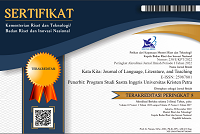THE MAN AT THE SELF-PAINTED WINDOW
DOI:
https://doi.org/10.9744/katakita.5.1.39-46Keywords:
Kompetensi, Pelatihan, Disiplin Kerja, Kinerja KaryawanAbstract
This creative project is an autobiographical novel that tells the story of Hero Widjaja, a Chinese Indonesian man who embarks on his journey to Hong Kong, Macau, and Mainland China to find his true identity. Having raised in a pretty conservative Chinese Indonesian family background, Hero learns that there is an unfinished business in finding his identity as a Chinese Indonesian man. His parents unconsciously indoctrinate him to identify himself just like Mainland Chinese people. On the other hand, Hero surely does not have Chinese citizenship or even speak Mandarin. One morning, his father offers him a free trip to visit his relatives in Mainland China. Keeping the desire to find his true identity, Hero decides to take the trip and prove it himself whether he is eligible to regard himself as Chinese. I decide to use Erikson’s stages of psychosocial development to identify Hero’s identity crisis. This theory aims to help me create problems and believable characterization for my characters to represent the identity crisis that Chinese Indonesian people may have in real life. As for the genre, I decide to choose biographical novel as the genre of my creative work. I mix my personal family experiences as a Chinese Indonesian man with fictional elements so that I can still catch my readers’ attention from the beginning to the end.
References
Bachrun, R., Hartanto, B. (2000). Krisis identitas diri pada kelompok minoritas Cina. In Wibowo (Eds.), Harga yang harus dibayar: Sketsa pergulatan etnis Cina di Indonesia. Jakarta: Gramedia Pustaka Utama dan Pusat Studi Cina.
Chandradinata, P. (2009, September 18). Kebudayaan etnis Tionghoa ditinjau dari tujuh unsur kebudayaan universal. Retrieved September 1, 2016 from: http://peterrchandradinata.blogspot.co.id/2009/09/kebudayaan-etnis-tionghoa-ditinjau-dari_18.html
Crain, W. C. (2011). Theories of development: Concepts and applications (6th ed.). Upper Saddle River, NJ: Pearson Education, Inc.
Doyen, B. (2007). What is a memoir? What makes a memoir different from an autobiography or biography?. Retrieved September 1, 2016 from: http://www.barbaradoyen.com/writing-nonfiction/what-is-a-memoir-what-makes-a-memoir-different-from-an- autobiography-or-biography
Gross, F. L. (1987). Introducing Erik Erikson: Aninvitation to his thinking. Lanham, MD: University Press of America.
Hernandez, S. M. (2015, April 15). How to write a memoir: 6 creative ways to tell a powerful story. Retrieved September 1, 2016 from: http://thewritelife.com/how-to-write-a-memoir/
Houston, T. (2012, February 29). Autobiographical fiction: Using your real life to craft great fiction. Retrieved September 1, 2016 from: https://litreactor.com/columns/autobiographical-fiction-using-your-real-life-to-craft-great-fiction
Macnow, A.S. (2014). MCAT behavioral science review. New York City: Kaplan Publishing.
Schultz, D.P., & Schultz, S.E. (2009). Theories of personality, 9th Ed, New York: WadsworthCengage Learning.
Showalter, S. (2012, September 11). Why is there a surge in memoir? Is it a good thing?. Retrieved September 1, 2016 from: https://janefriedman.com/memoir-trend/
Susetyo, D.P.B. (1999, June 1). Asimilasi etnis Cina di era reformasi. Surat kabar harian Solo Pos. Retrieved September 1, 2016 from http://budisusetyo-inside.blogspot.co.id/2010/01/krisis-identitas-etnis-cina.html
Susetyo, D.P.B. (2002). Stereotip dan relasi antar etnis Cina dan etnis Jawa pada mahasiswa di Semarang. (Unpublished master’s thesis). Universitas of Indonesia, Depok, Indonesia.
Thayalamoorthy, K., & Ratchagar M. ( August 8, 2016). Autobiographical elements in the novel Five Point Someone by Chetan Bhagat. Retrieved August 8, 2016 from www.languageinindia.com/aug2016/thayalafivepointsomeone.pdf
Wahyudi, I. (2013). Yang orisinil lebih menarik, Retrived September 1, 2016 from: http://www.kompasiana.com/iwanwahyudi/yang-orisinillebihmenarik_552a0f81f17e615452d623ce
Downloads
Issue
Section
License
Authors who publish with this journal agree to the following terms:- Authors retain copyright and grant the journal right of first publication with the work simultaneously licensed under a Creative Commons Attribution License that allows others to share the work with an acknowledgement of the work's authorship and initial publication in this journal.
- Authors are able to enter into separate, additional contractual arrangements for the non-exclusive distribution of the journal's published version of the work (e.g., post it to an institutional repository or publish it in a book), with an acknowledgement of its initial publication in this journal.
- Authors are permitted and encouraged to post their work online (e.g., in institutional repositories or on their website) prior to and during the submission process, as it can lead to productive exchanges, as well as earlier and greater citation of published work (See The Effect of Open Access).














